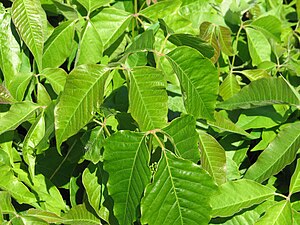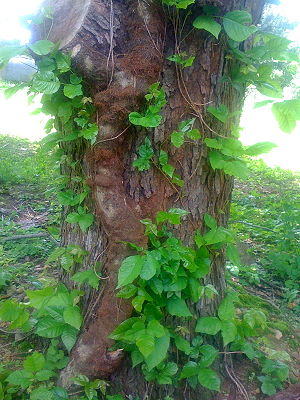We are blessed in Ontario to be surrounded by an abundance of trees, shrubs, vines and other flora. Some provide shelter and nesting places for birds, animals and a myriad of insects. Others are a great source of food for man and beast alike. They often improve air quality, can prevent soil erosion, as well as filter water. Isn’t nature great?!
Not all plant life can lay claim to such glowing reviews though. There are some species that exist which seem to have pain and suffering as their main goal. They might be covered in thorns to dissuade visitors, like hawthorn trees. Some might emit a terrible stench to repel anyone from getting close, like skunk cabbage (although flies love it). And yet others that harbour a poison within their leaves, that will leave you regretting ever having come in contact with it, like Toxicodendron Radicans. If you have never come across it before, consider yourself lucky, but chances are you have seen it at least. This common plant, found across North America, is commonly known as Poison Ivy.
Poison Ivy is not always so easy to distinguish. It can be a shrub, trailing vine, or even a climbing vine. You can find it on the edge of forests, on roadsides, in clearings, and even in your own backyard. It can climb trees, posts, fences, along the ground, and even appear as a dense shrub that you don’t ever want to stick your hand into. This virulent plant grows in sandy areas, as well as rocky ones, and while it prefers a sunny area, can be found in dappled shade too. And due to the fact that it loves carbon dioxide, it has become a lot more common in the last fifty years, with chances are that you will see a lot more of it in the years to come.
So what is it about poison ivy that is so bad? The leaves contain an oil called urushiol that causes an extremely itchy rash in most people. A rash doesn’t sound so bad, right? If you can’t wash off the oil in less than 15 minutes, I’m sure you will beg to differ. Within 2 hours you will begin to itch. That itch will lead to a red rash that will see you itching for the next 2-3 weeks. You might even develop painful blisters. While some lucky souls are not prone to this allergy, roughly half (if not more) of the people exposed to it are. Do you want to take that chance?
What you really need to know is how to AVOID poison ivy. It has three-pointed leaflets, with the middle leaflet on a longer stalk. The leaves are red in the spring, turn green in the summer, and in the fall fade to various shades of red, orange and yellow. They grow on a woody vine and can be anywhere from 8-55 mm in length. Flowers appear in June and July that range from cream to a yellowish-green colour, followed by round, waxy berries in September. The clustered berries are yellow to green in colour as well and 3-7 mm in diameter.
ALL PARTS OF POISON IVY CONTAIN URUSHIOL.
Avoid contact with any part of it, including the roots. Be cautious even if you brush up against it fully clothed, as the oil sticks to shoes, shoelaces, clothing, tools, and even animal’s fur. Never burn it, as the smoke can cause damage to your lungs (even death). Never eat it, as your airways, kidneys and digestive track may all be painfully affected. That goes for live plants, as well as dead ones. Urushiol can stay active on any surface for up to 5 years.
If you do have the misfortune to come in contact with poison ivy, there are things you can do. Wash the affected area immediately in soap and cold water. Vinegar or alcohol can be used if soap is not available, but stay away from hot water, as it opens the pores allowing the oil to penetrate more deeply. Calamine lotion may reduce itching. Natural home remedies like aloe vera gel or plantain leaf compresses may bring relief and a reduction in swelling (both anti-inflammatories). Witch hazel soothes the skin, as might a cloth dipped in cool milk. An oatmeal or Epsom Salt bath will help to dry out a rash. If the itch is still driving you mad, a trip to the doctor might be in order too.
Take our very own arborist, Calvin McCallum’s word for it. With the rash he’s suffering from, he won’t be messing with poison ivy again…







[…] when they came across a particularly nasty plant that left behind its own reminders. The post One, Two, Three; Don’t Touch Me was all about poison ivy. I am sure that Calvin remembers the encounter that led to this post, […]
[…] One, Two, Three; Don’t Touch Me! […]